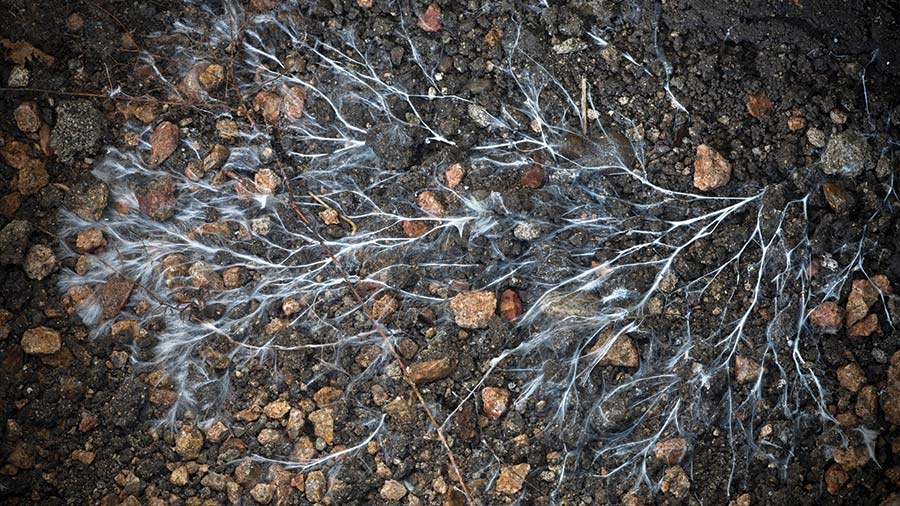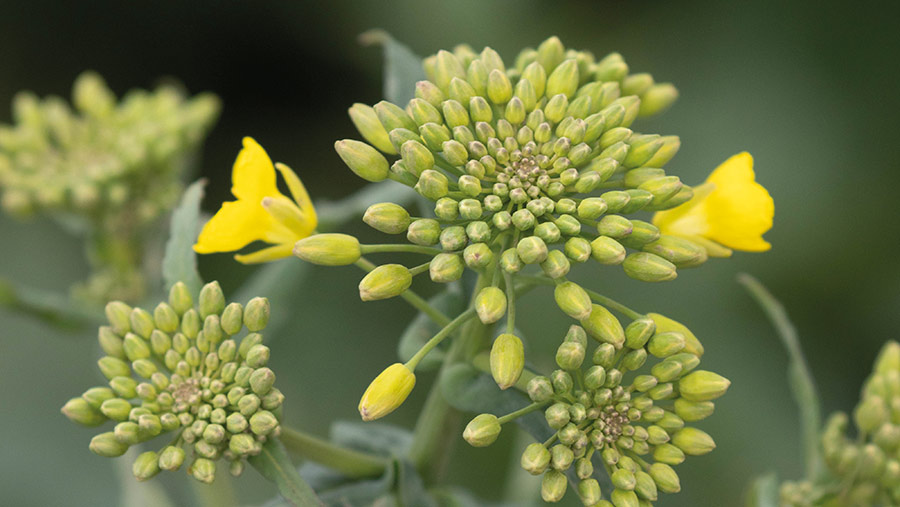How natural fungi can be encouraged to aid crop production
 Mycorrhizal fungi © Emmanuel Lattes/Alamy Stock Photo
Mycorrhizal fungi © Emmanuel Lattes/Alamy Stock Photo Mycorrhizal fungi play a valuable role in maximising crop performance, and a team of researchers is on a mission to delve deeper into the world of mycorrhizas to explore how fungal populations can promote crop production.
By genetically engineering plants with different expressions of target genes, researchers at Cambridge University’s Crop Science Centre hope to optimise fungal colonisation of crop roots and reduce artificial inputs.
See also: Olly Harrison sows OSR and cover crop with quadcopter drone
What we know already
Arbuscular mycorrhizal fungi are widespread in soils and grow in association with plant roots, playing an important role in the plants’ nutrient and water uptake, explains Dr Tom Thirkell, a researcher at the Crop Science Centre.
“The symbiosis can bring added benefits to plants, such as improved defence against pests and pathogens, increased water use efficiency, improved soil structure, and tolerance to heavy metals.
“Soils rich in these fungi can also show lower greenhouse gas emissions,” he says.
Mycorrhizal fungi are found in virtually all farmed soils. About 70% of plant species (notably excluding brassicas – see box below) use this symbiosis, which sees fungi colonise internal root tissue and develop external structures called hyphae.
These hyphae extend into the soil and increase the surface area from which plants can access essential nutrients. Mycorrhizas also play an important role in building soil structure,
Previous studies have shown that mycorrhizal fungi can provide crops with 100% of their phosphorus uptake and a significant proportion of their nitrogen.
“It is often said that plants don’t have roots – they have mycorrhizas,” says Tom. “I think that’s fair to say, given how abundant and widespread mycorrhizas are.”
The gene-editing trial
In collaboration with Niab, the research team at the Crop Science Centre are carrying out a spring barley field trial investigating the effect of a nodulation signalling pathway gene known as NSP2.
This gene is central to the signalling process between plant and fungus.
However, the NSP2 genes are usually expressed only when plant nutrients are in short supply.
“In low-phosphorus scenarios, we see high colonisation of mycorrhizal fungi in the roots, whereas in high-phosphorus scenarios there is low colonialisation,” he says.
It is believed this happens because the plant does not need to engage with the fungi, as it has plentiful supply of phosphorus available.
Therefore, artificial inputs often cause plants to reject the fungi, which means mycorrhizas tend to be more abundant in organic and low-input systems.
The research team says it is possible to gene edit and genetically modify plants to overexpress the NSP2 gene, increasing the activity of the signalling pathway and allowing fungi to colonise the root in high-P scenarios.
The team hopes that increasing mycorrhizal colonisation can then bring greater crop benefits.
Modified spring barley
This technology has already been tested in glasshouses and is now moving to field-scale trials of Golden Promise spring barley.
Genetically engineered lines of winter barley are being investigated in the trial.
The first is a genetically modified barley which has increased expression of the NSP2 gene to enhance colonisation.
It contains DNA from Medicago truncatula – a small annual legume commonly used in genomic research.
The second is a gene-edited barley which has had symbiosis signalling genes knocked out, preventing fungal associations from forming.
This will act as a control to identify the role fungi play in the natural environment and how colonisation can be promoted.
Parasitism v mutualism
Although fungi colonisation is important, Tom says it does not guarantee a benefit to crops.
“For reasons we still don’t fully understand, not all plants receive the same benefit from mycorrhizal colonisation. In some cases, the fungi are beneficial, but in others they can act almost like parasites on their plant hosts.
“This may be due to unequal exchange of resources between plants and fungal partners or something similar to a defence response – the plant mistaking the mycorrhiza as a pathogen rather than a symbiont.”
For example, when investigating 99 different wheat lines from an Avalon x Cadenza mapping population, fungal colonisation resulted in a broad range of shoot biomass differences.
In some cases, fungal inoculations caused an almost doubling of shoot biomass. In other wheat lines, the mycorrhizas caused a growth penalty – a 30% reduction in shoot biomass.
“The cause of this is still unclear; we’re working to ensure the plants respond positively,” he says.
Promoting mycorrhizal fungal colonisation on-farm
Mycorrhizal populations are most healthy in undisturbed soils, particularly permanent pasture, field edges and woodland.
Keeping living roots in the soil throughout the year will help promote fungi colonisation, while soil disturbance (physical, chemical or biological) disrupts fungal networks.
“The greater the abundance and the diversity of the fungi networks in arable soils, the greater the benefit to the growing crops”, says Dr Tom Thirkell.
“Through this sampling project, we hope to investigate the impacts of different management practices and how we can optimise this to promote the most beneficial fungal populations,” he says.
A farmer-led project, in collaboration with the British On-Farm Innovation Network (Bofin), plans to take root samples from across the UK to build up a greater knowledge of mycorrhizal fungi.
How much mycorrhizal fungi is present in UK farm soils? How does farm management affect mycorrhizal colonisation? Are populations of mycorrhizal fungi the same by crop, soil type and location?
These are just a few of the questions the project hopes to address.
A “soil squad” formed of more than 50 farmers have tested root samples and sent them to the Crop Science Centre for analysis to quantify the amount of mycorrhizal fungi in crops.
“This is the first time UK arable crops have been benchmarked in this way,” says Tom.
Mycorrhizal benefits for brassicas
Brassicas including oilseed rape, cabbage and mustard are unusual among crops in that they do not form mycorrhizal associations.
Exactly why this is remains a mystery, but it is thought that the brassicas evolved alternative methods to obtain soil nutrients such as the excretion of enzymes and acids.
Consequently, their fungal associations were lost.
Growing companion crops that are susceptible to mycorrhizal colonisation alongside brassicas may provide an indirect way of promoting mycorrhizal benefits to these otherwise non-mycorrhizal crops.

© Tim Scrivener

